If you’re a runner, a nature lover, and lucky enough to live near some beautiful mountain ranges, ocean cliffs, deep green forests, or arid deserts then the chances are pretty high that you own a pair of trail running shoes.
Running on the road is more fast-paced and makes for a much more consistent forward movement. If you, like most runners, prefer to get up in the morning and conveniently head out your door for a run around your neighborhood, then the chances are pretty high that you own a pair of road running shoes.
Road running shoes and trail running shoes both have their key differences, these are there to ensure you are capable of making your way on the differing terrains. In order to do so, your shoes need to protect your feet and provide traction & stability.

If you were to hold a trail running shoe up next to a road running shoe you would easily notice a few differences between the two, let’s have a deeper look into those differences…
Primary Differences Between Trail & Road Running Shoes
| Trail Running Shoes | Road Running Shoes |
| Thick uppers | Breathable uppers |
| Stability features | Fewer stability features |
| Heavy | Lightweight |
| Gusseted Tongue | Different Tongue Styles |
| Darker Colors | Different Colours Available |
| Protected Toe Box | Breathable Toe Box |
| Stickier Rubber Outsole | Smooth, Blown Rubber Outsole |
| Stiffer Midsoles | Flexible Midsoles |
| Rock Plate | No Rock Plate |
So, we’ve established that there are quite a lot of differences between trail runners and road runners, but what do they all mean exactly?
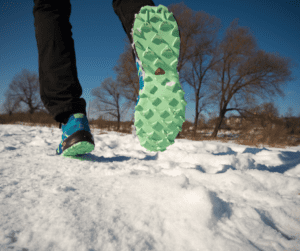
Road Vs Trail: Outsoles Of Shoes
One of the first and most visible differences between trail and road running shoes is in the outsoles. These are the bottom of the shoes.
Trail running shoes have large lugs, big teeth, and a stickier rubber for improved traction on dirt, mud, and rocks. It’s better to match your shoes to the surface you’ll be running on as the size and shape of the lugs depend on the type of terrain.
Road running shoes are meant to help you to push off even surfaces quickly and efficiently. They have flatter soles that create a consistent surface to run on pavements and tar roads.
Road Vs Trail: Stability Of Shoes
Both types of shoes have stability features, these are there to provide your feet, and ankles with protection and are usually along the sides and under your foot.
Trail running shoes generally have more stability features compared to road running shoes, this is because trail running shoes need to withstand harsher terrains, jumping over roots, gritty dirt, and sharp rocks.
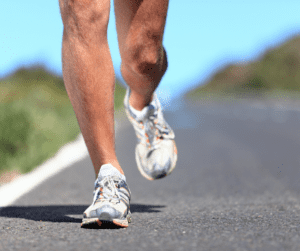
Road Vs Trail: Weight Of Shoes
Road running shoes aim to be as light as possible, this will result in faster running times, less energy expenditure, improved biomechanics, and an overall boost in stride efficiency. Trail running shoes are heavier than road runners, to be able to provide protection and support.
Based on the research I did, trail runners seem to come in 3 categories.
For light trails:
These are the lighter trail running shoes, these provide support on well-maintained trails but still contain the elements that make this shoe a trail running shoe.
For rugged trails:
These trail runners are a bit chunkier, they can withstand loads of different types of terrains and are therefore a bit heavier.
Off-trail:
These are the type of trail shoes for the extreme trail runners, these can withstand the rockiest terrains and slipperiest forest floors, no trial required. These shoes are probably as heavy as trail running shoes get.
(Most running shoes nowadays can hardly be called “heavy” anyways, we’re lucky to live in a time where technology is so advanced that none of us have to be running in clunky, chunky boots)
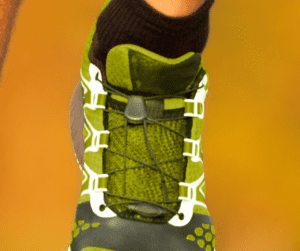
Road Vs Trail: Shoe Tongue
The tongue is the piece of your shoe that sits under the laces.
The purpose of a tongue is to protect the top of the foot and to stop your laces from rubbing against the top of your foot.
Trail running shoe tongue: A gusseted tongue is attached to both sides of the shoe to keep water, rocks, and sand from sliding through your laces and into your shoe. Some trail running shoes also have a burrito tongue, which is only connected on one side. Burrito tongues are easier to get on and off.
Road running shoe tongue: This ‘normal’ type of tongue moves up and out to allow your foot to slide into the shoe.
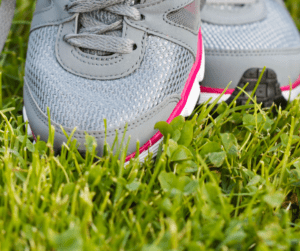
Road Vs Trail: Toe Box Of Shoes
The toe box of running shoes, in general, is important as it covers and protects the toes.
Toe boxes vary according to the type of shoe, they should always be wide enough and long enough to accommodate the toes comfortably and safely.
Road running shoe toe boxes are minimal, lightweight, and as breathable as possible.
Trail running shoe toe boxes are often wider and covered in a protective layer of rubber. Trail running shoes also often have toe bumpers to protect toes from those rocks and roots that tend to pop up out of nowhere.

Road Vs Trail: Shoe Midsoles
Placed between the outsole and the upper sole, the midsole plays an important role in providing your foot with shock absorption, flex support, and cushioning.
The midsole of a trail running shoe is generally stiffer to provide more support on trails and rockier surfaces. Some trail-running shoes even include rock plates between the midsoles and outsoles that add extra protection against sharp objects.
The height difference between the heels and toes (the drop) varies hugely between all types of shoes. The difference is based on how the shoes are made to perform as well as personal preference.
It’s important to note that your anatomy also plays a big part in which size drop best suits you.
Road running shoe midsoles are not as stiff as trail running shoes but they still need to provide some cushion protection to the feet from the hard pounding on roads or pavements.
Road Vs Trail: Shoe Uppers
The upper of a shoe consists of all the sections of the shoe above the sole.
Trail shoe uppers are reinforced with synthetic overlays in key spots to protect the shoes and your feet. These key spots are around the toes, heels, and sides of the shoes. Some uppers on trail shoes have gaiter attachment points and lace pockets (to stuff your shoelaces into). Some even have a waterproof coating which is also a big added benefit. (Bear in mind that some waterproof shoes are nice for wet conditions but won’t drain out easily)
Road running shoe uppers don’t need much reinforcement and instead have lots of mesh to keep the shoes lightweight and breathable.
There is no single running shoe that is perfect for everyone. So how do you find the shoe that is perfect for you?
Let’s dive into how to choose the perfect pair of road running shoes…
How To Choose a Pair Of Road Running Shoes
- Choose The Right Type of Road Running Shoe
- Get The Right Fit
- Understand What You’re Paying For
- Know The Lingo
- Wear Your Running Socks
Choose The Right Type Of Running Shoe
Your running shoes should be chosen based on the kind of running you intend to do.
In terms of road running shoes, you could look at buying an everyday running shoe that can handle all the running most people do, this would be a more versatile option. Or you could opt for a lightweight running shoe, this would obviously be for faster training sessions or races.
Get The Right Fit
The most important factor to consider when buying road running shoes is how well they fit.
A road running shoe that doesn’t fit well will lead to injury and make your running experience painful.
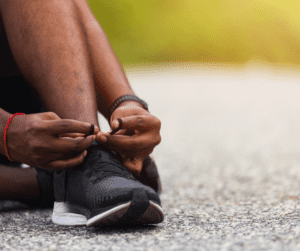
When trying on your road running shoes consider these tips:
- There should be one thumb’s width between the end of your foot and the end of your shoe to make room for foot spread and to stop your feet from swelling on downhill runs.
- Make sure to try your potential road running shoes on at the end of the day, this is because feet swell throughout the day, just as they do when you run.
Understand What You’re Paying For
You don’t have to buy the most expensive road running shoes to enjoy a run.
A more expensive shoe normally correlates with better comfort features and more technology whereas a very inexpensive shoe may mean that it isn’t designed to handle the running demands.
Some research suggests that according to most runners, inexpensive running shoes are higher rated compared to expensive ones.
Know The Terminology
Heel-toe drop:
The difference between the amount of material under the heel and the amount of material under the forefoot of a running shoe.
Pronation Control:
Running shoes can be classified as either neutral or stability shoes.
Neutral running shoes offer the largest selection and are best for 80% of runners.
Stability running shoes contain technology that is designed to correct overpronation. (when the ankle rolls excessively inward with each step)
Check out this video where Coach Lindsey and Brad talk about running shoe basics & whether or not you should be running in neutral or stability running shoes: Click here
Stack Height:
Stack height refers to the amount of material between your foot and the ground.
These can range from minimally cushioned to highly cushioned.
Wear Your Running socks:
By trying on your shoes with the same running socks that you plan to wear on your runs, you have a better chance of ensuring the perfect fit.
Now that you know what to look for when buying a pair of road running shoes. We’ve put together a male and female comparison of the top five road running shoes of 2022.
Top 5 Male Road Running Shoes 2022
| Name | Type | Weight | Heel-Toe Drop | Key Features | Category | Price | Link |
| ASICS GEL-Nimbus 24 | Long-distance training | 10.2 oz | 10 mm | The upper’s soft engineered mesh and flexible midfoot panel make these shoes more comfortable during long runs. | Neutral | $160.00 | Here |
| Nike Air Zoom Pegasus 38 | Daily training & road racing | 10 oz | 10 mm | Nike React foam is lightweight, springy, and durable. More foam means better cushioning without the bulk. | Neutral | $158.77 | Here |
| Hoka Mach 4 | Designed for logging long miles | 8.60 oz | 5.00mm | Extended heel designed for a smooth, stable run. | Neutral | $130.00 | Here |
| Brooks Glycerin GTS 19 | Ultimate comfort for your run | 10.6oz | 10mm | GuideRails holistic support system: Innovative technology supports your whole body in its natural stride while keeping excess movement in check. | Stability | $150,00 | Here |
| Altra Rivera | Daily runs and occasional races | 9.1 oz | 0 mm | Altra EGO midsole, a neutral Innerflex outsole for flexibility and performance. | Neutral | $129.95 | Here |
Top 5 Female Road Running Shoes 2022
| Name | Type | Weight | Heel-Toe Drop | Key Features | Category | Price | Link |
| Brooks Ghost 14 | Road training and racing | 8.99 oz | 12mm | The updated midsole is now 100% DNA LOFT cushioning for an even softer, smoother run. | Neutral | $140.00 | Here |
| Saucony Endorphin Speed 2 | From speed work to longer runs, from workouts to race day | 7.0 oz | 8mm | XT-900 outsole with reinforced high-abrasion zones provides optimal traction and durability. | Neutral | $160.00 | Here |
| Nike Air Zoom Pegasus 38 | For everyday miles or long runs | 8.9 0z | 10mm | Breathable mesh in the upper combines the comfort and durability you want with a wider fit at the toes. | Neutral | $130.00 | Here |
| Asics GT 2000 10 | Functional for various distances | 8.4 oz | 8mm | Is made for neutral and overpronation. | Stability | $130.00 | Here |
| Altra Torin 5.0 | Long-distance running | 7.3 oz | 0mm | The improved heel collar helps keep you locked in for a secure step cycle. | Neutral | $150.00 | Here |
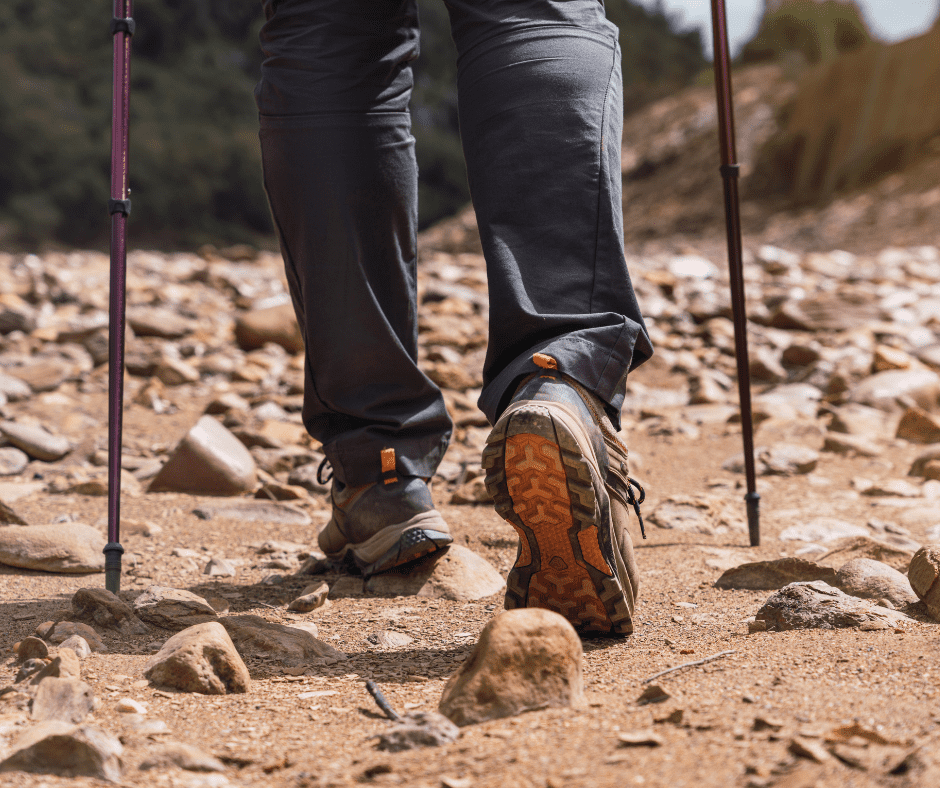
Just like road running shoes, there is no single trail running shoe that is perfect for everyone.
It can be hard to know where to begin when choosing your trail running shoes…
Here are some guidelines to make the process easier.
How To Choose a Pair Of Trail Running Shoes
- Shoe Type
- Cushioning/ Stack Height
- Heel-To-Toe Drop
- Lug Length
- Shoe Weight
- Price
Shoe Type
Choosing trail running shoes starts by assessing the type of trails you plan to run on.
Trail-running shoes fall within three categories:
- Light Trail: Shoes made for light trails will be the closest in weight and build to road-running shoes. They provide some protection from rocks and are lightweight to maintain a brisk pace.
- Rugged Trail: Shoes made for the broadest spectrum of terrains. They offer a lot more underfoot protection and support.
- Off Trail: Shoes made for where the man fears to tread…off-trail. They offer aggressive outsoles and an enhanced structure for protection over extremely versatile terrains.
Cushioning/ Stack Height
Cushioning level or stack height has been drastically changed over the last few years, shoes with no padding (zero drop) and shoes with massively cushioned midsoles have revolutionized the industry.
The cushioning spectrum offers you a wide range of options from barefoot shoes (no-padding shoes), minimal shoes (good option for runners wanting a better feel), moderate shoes (traditional trail runners) to maximum shoes (heaps of padding in the midsole).
Heel-To-Toe Drop
Barefoot shoes have a 0 mm drop, Minimalist shoes typically have a drop of 0 to 4mm, moderate and maximalist shoes offer a wide range of heel-to-toe drops.
Considerations when choosing a heel-to-toe drop:
- A low heel drop encourages a midfoot or forefoot strike.
- Match the drop of your current running shoes. (If you don’t have running shoes, look at your other shoes.)
- Take it slow If you are considering changing to barefoot shoes.
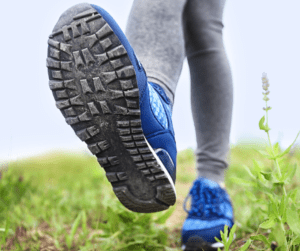
Lug Length
You will want your trail running shoes to have grippy soles to navigate uneven terrains.
It’s important to look at the type of terrain you plan to run on before deciding on your lug length. If the terrain you plan on running in is mostly covered with stones and hard dirt, a short lug pattern will be perfect. If you live in an area that gets a lot of rain then for muddy & soft surfaces you’ll need a deeper lug pattern.
Shoe Weight
Trail running shoes should be as light as possible while still offering the protection you desire.
There’s no worse feeling than having to lift heavier shoes over the course of a long run… your legs begin to feel like dead weight!
Price
More expensive doesn’t always mean better.
Judge the trail running shoe you are thinking of buying by what it offers, not the price tag.
Now that you know what to look for when buying your trail running shoes before you hit the shops and jump onto the trails, have a look at these male and female trail running shoe comparisons of 2022.
Top 5 Male Trail Running Shoes 2022
| Name | Type | Weight | Heel-Toe Drop | Key Features | Category | Price | Link |
| Saucony Peregrine 11 | Any type of rugged terrain | 10 oz | 4mm | Aggressive lugs made of PWRTRAC tacky rubber conform to dig in and confidently grip a wide variety of terrains. | Neutral | $94.95 | Here |
| Altra Lone Peak 6 | All-terrain | 10.6 oz | 0mm | Grippy MaxTrac outsole with TrailClaw canted lugs designed to keep you going. | Neutral | $139,95 | Here |
| Inov-8 TrailFly Ultra G 300 Max | For Ultra trail running | 10.5 oz | 6mm | Featuring the world’s first Graphene-enhanced foam, called G-FLY. | Neutral | $190.00 | Here |
| Brooks Cascadia 16 | All-terrain | 10.5 oz | 8mm | Ballistic Rock Shield now includes vertical grooves to provide side-to-side adaptabilities. | Neutral | $130,00 | Here |
| Salomon Speedcross 5 | Muddy and soft terrains | 11.6 oz | 10mm | Lug design with deep penetration and multi-directional grip, improving traction on soft surfaces like mud or loose dirt. | Neutral | $150,00 | Here |

Top 5 Female Trail Running Shoes 2022
| Name | Type | Weight | Heel-Toe Drop | Key Features | Category | Price | Link |
| Topo Athletic Ultraventure 2 | For technical trails | 8.3 oz | 5mm | An internal microfiber belt wraps the midfoot and is combined with an external TPU heel counter to secure and lock the foot in over the platform. | Neutral | $135.00 | Here |
| Saucony Peregrine 11 | All-terrain | 9.5 oz | 4mm | The new ultralight, durable top layer adds durability to the comfortable air mesh bootie so nothing snags your speed. | Neutral | $94.95 | Here |
| Brooks Catamount | Long-distance trail running | 9.7 oz | 6mm | A raised tread pattern and our unique TrailTack rubber make it easier to grip the ground when traveling uphill or downhill. | Neutral | $160,00 | Here |
| Women’s Trans Alps™ F.K.T.™ III | For mountain trails | 9.25 oz | 5-8mm | Contains a full-length puncture-resistant rubber outsole. | Neutral | $77.90 | Here |
| MERRELL MTL LONG SKY | For long runs in rugged mountain terrain. | 9.8 oz | 8mm | Made of a lightweight, tear-resistant fabric, a medial post, and an aggressive Vibram® MegaGrip rubber sole | Stability | $104,00 | Here |
Now that you have a clear breakdown of the different types of trail running shoes, you might be asking yourself, if it’s possible to run on the road with your trail running shoes, or is it possible to run on trails with your road running shoes…
Using Your Trail Running Shoes On The Road
As we have mentioned above, trail running shoes offer protection, stability, and more importantly traction, which is what is needed when running on rugged & versatile terrains.
Trail shoes are safe to wear on your road runs because they do provide the stability and support that is required. One may find their trail running shoes to be too heavy/ clunky, which could affect the road running speed, this is when having specific road running shoes would be a better option.
Let’s look at this scenario from the opposite direction…
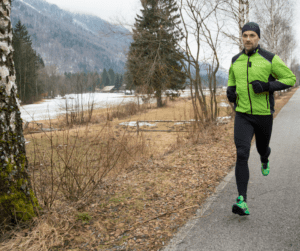
Using Your Road Running Shoes On a Trail
Based on numerous studies, including the data above, we advise against running in your road running shoes on trails. This is because road running shoes are designed for running fast on pavements & roads. They aren’t designed to provide the level of protection needed for your feet on trails.
It Is Possible To Have Both In One Shoe
There is a type of shoe that is growing more and more in demand with runners who love both trail and road running, It performs equally well on roads and trails and is called a hybrid shoe.
Hybrid Shoes
Hybrid shoes are for people who want to run trails some days and on the road on other days, or even for people who run a combination of road and trail all in one run.
Running shoe companies like Asics, Brooks, The North Face, and Salomon have made trail running shoes that contain characteristics that make them run well on-road and pavements too.
Whether you have decided to get some trail running shoes, hybrids, or road running shoes, these tips on how to care for your new/current shoes are going to ensure you get the most mileage out of them as possible.
Check it out: Here



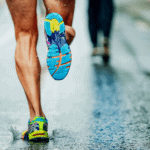
Comments are closed.